Vanlife is far more than a trending hashtag to this trio of intrepid road warriors turned temporary actors in the Oscar-nominated, Golden Globe-winning drama. So don’t think for a minute they’re just doing it for the ‘gram.
When COVID-19 swooped in, closing most international borders for more than a year, making plane travel risky, and lurking in more dangerous concentrations inside and among crowds, it affected and changed almost every aspect of our lives from going to work and socializing to how we celebrated holidays and, of course, how we R&R-ed. Well, most of our lives anyway. For the three main real-life nomads director Chloe Zhao plucked from their dirt-road retirement village and enlisted them to play quasi-fictionalized versions of themselves in Nomadland, a moving film about one woman’s roving journey through grief and seasonal employment in the American West and Plains nominated for several trophies this upcoming Oscar Sunday, it was mostly business as usual.
“If not [for] TV and social media, I wouldn’t have even noticed the pandemic,” Swankie, a self-proclaimed “crabby old granny desert rat” who prefers to be alone in her van, tells Fodor’s. “I have done exactly what I would have done if the pandemic had never happened except for being more careful when I need to resupply. [Nomads] set up to live off grid [were] so much better prepared than people living in sticks and bricks.”
Bob Wells felt equally prepped and didn’t have to adjust much of his daily routine either.
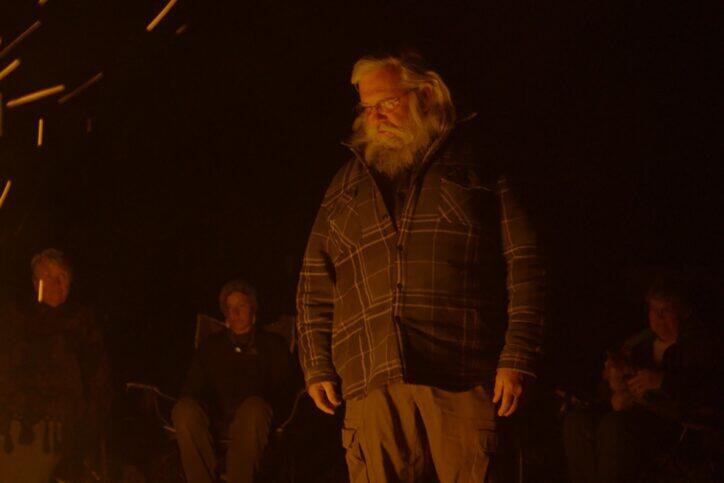
I was never that worried because it’s very easy to socially distance yourself as a nomad,” says Wells, the longtime van-dwelling vlogger behind the CheapRVliving YouTube channel and website as well as the annual nomad meet-up, the Rubber Tramp Rendezvous, a recreation of which features prominently in the film. (As it draws thousands of people to Quartzsite, Ariz., the 2021 event went virtual, which was the one real pandemic concession Wells and his co-organizers had to make.)
“When I wake up and step out of the van, the only people around me are people I invited to camp and we had agreed mutually to wear masks, stay six feet apart, be safe, and be smart. We only talk to each other outside. We don’t go into each other’s rigs. The only time I was inside with others was when I was in town those few hours a week to buy groceries, get gas, get water, and dump my trash. After I leave there, I’m completely free again. I could travel anywhere I wanted any time I wanted.”
That specific brand of freedom has kept Wells on the road since 2008. He also thinks others yearning to know that freedom to roam, to live more simply, and spend more time in nature is partially driving both the recent explosive growth in the nomad scene and the uptick in road trips, camping, and U.S.-based getaways. “I think 99% of the time if you asked a nomad why they do this, the answer would be freedom,” says Wells adding that it was interesting to watch the pandemic push the 40-hours-plus-a-week crowd to flee cities and adopt lifestyles that looked a lot more like their counterculture way of life. “The more [nomads], the better. There are a few people who have found this way of life and they don’t want anyone else to find it. But they’re the exception.”
This is not to minimize the darker reasons folks pack up and invest in a rolling residence like the lack of eldercare in this country, the disappearing American dream, the high cost of living, mental illness, and grief, the latter being the initial reason the film’s main character Fern (Frances McDormand) hits the highway.
“Nomadic living is a very big tent and under that tent are many smaller tents. Fern starts as a nomad [after] an enormous loss and her story is the story of an awful lot of people who choose this life. The [film] captured nomadic living when you’re on the ragged edge of economic wellbeing perfectly,” Wells says. “But if you’re 30, got rich in Silicon Valley, have a million dollars in the bank, and now live in a Subaru Forester, and I know those guys, it didn’t tell that nomadic story. Once he gets in his Subaru, that part of nomadic life is almost identical. He has to figure out all the ins and outs, same as Fern, same as all of us.”
“Society molds us into giant ruts. We’re given a lot of freedom in the enormous ruts. We can change states, houses, companions, and jobs. But you better stay in that rut and not try to get out. I tell people there is a whole way of life outside the rut.”
The freedom aspect also contributes to why audiences are responding to the movie—there’s an almost vicarious satisfaction of wanderlust that occurs as you stream Nomadland on Hulu and watch the sun come up over the striated spires of Badlands or see McDormand’s hair become matted by the wet air of a California redwood grove, especially if you’ve spent the entire pandemic responsibly staring at the same four walls—and why Zhao was the perfect director for it.

“Chloe totally got it. She’s a traveler and a listener [who] appreciates being wild and free,” says Linda May, another nomad who appeared in both the film and the Jessica Bruder book it was adapted from. “She understands the sentimentality of connecting with nature and people with like minds. She understands the inner peace and the fulfillment you get when you come upon a million-dollar view and it’s all yours for the day. And it didn’t cost you a dime outside of the gas to get there.”
In fact, Zhao, who has spent weeks at a time car camping in her Subaru and who built out and customized a camper van named Akira to live in during much of the shoot, not only understands the concept but feels it deep in her bones and has since she was a child in China and England. “Having grown up in cities, I’ve always been deeply drawn to the open road—an idea I find to be quintessentially American—the endless search for what’s beyond the horizon,” the writer/director explains in the movie’s production notes. “I tried to capture it in this movie, knowing it’s not possible to truly describe the American road to another person. One has to discover it on one’s own.”
That doesn’t mean future mobile homeowners, or temporary transients for that matter, can’t steal route info from the story that follows Fern through five states (California, Nevada, South Dakota, Arizona, and Nebraska) and a series of odd jobs, including campground host and Wall Drug waitress, or glean some useful travel tips from the trio who, between them, has more than half a million miles and four decades on the road under their belts. Wells is happy to help.
“I do everything I do—the website, the YouTube channel, the Rendezvous—to help as many people as possible live their best lives,” Wells says. “Society molds us into giant ruts. We’re given a lot of freedom in the enormous ruts. We can change states, houses, companions, and jobs. But you better stay in that rut and not try to get out. I tell people there is a whole way of life outside the rut.”
Fodor’s talks with the nomads to get more of Wells’ philosophies, #vanlife tips, and favorite places to hang out as well as those of Swankie and Linda May.
Bob Wells
Before becoming an off-grid guru, he spent most of his pre-nomadic life working as a grocery store clerk in Anchorage, Alaska. His first stint of car living came in the wake of a divorce. He “couldn’t afford to pay for two households” and figured if he “could live out of a backpack for weeks at a time as a camper,” he could make the for-sale van he drove past every morning work until he could retire, draw his pension, and move down to the lower 48 in 2006. It was meant to be a temporary solution, but turns out he’s well-suited to the lifestyle as an avid camper and backpacker. After the first month, he hasn’t once regretted putting his old life in the rearview mirror.

Years On The Road: 13
Current Ride: A standard delivery van with a high-top, but he’s in the process of acquiring a used ambulance. “I’m moving up in the world.”
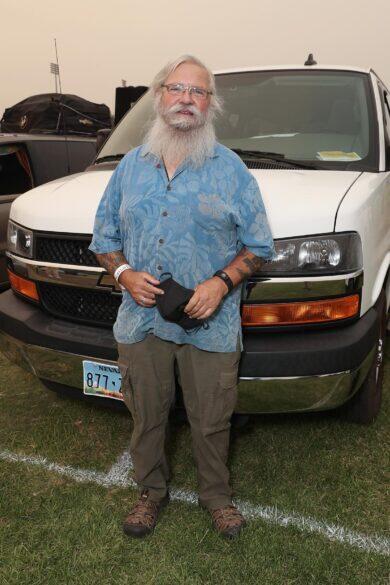
Why He Became A Nomad: “Freedom. If you think about your life and my life before, our lives are controlled by the dollar. You gotta pay someone for the home you’re in. You’re paying a bank or a landlord. You’re paying taxes and insurance. Every 30 days you have to come up with that money or you’re going to live on the street. He owns your life. To pay him, you gotta have a job so that means you have a boss. Your boss tells you when and where to be and how you are going to do your job. Now you got two bosses who get to tell you everything about your life practically. In your day, how much time do you have that you can say, ‘I can do anything I want?’ Out of your week? Your year? The next decade? Out of the next four decades? I didn’t like the answers when I asked myself those questions so I eliminated one of the lords in my life. When I didn’t pay him $1,000. I paid myself. That gave me a lot of choices. I gained freedom to make daily choices that no one controls but me.”
Hardest Part: “That was a long time ago but in 1995, the first time I moved into a van, the biggest problem I had was finding power because [there wasn’t] much solar on a small scale, not that you can even do solar in Alaska in wintertime, and generators weren’t that good back then either. The other problems like how to go to the bathroom I figured out pretty quickly because I had been a camper. I bought a cooler and a camp stove. I built a little cabinet in my van with basic carpentry skills. And I was living in a city so I went to the gym every day and took my shower.”
Favorite Places To Visit: “We are snowbirds. We travel north in the summer; south in the winter to try to stay in reasonably good weather all the time. I camp almost always in Arizona in roughly the same spot. In the summer, my favorites by far are Colorado and Utah. Those are my two favorite states. Colorado has the Rocky Mountains. They are stunning, gorgeous, fantastic. I love, love, love the mountains and need to be in the mountains as often as possible. I need to look at the big peaks, smell the fresh air. Utah I love because of the red rock country like out by Arches National Park. Zion is great. Utah has five national parks and each one is more stunning and beautiful than the others. And right around them, there are more national parks and state parks. Grand Canyon is just south. Monument Valley is a fantastic place. The natural beauty in those states and in this country is never-ending.”

Advice To Aspiring Nomads: “Number one, start getting rid of things and learn not to buy more. That’s hard [especially] getting rid of sentimental things. But the less you have in your rig, the better and more comfortable your life will be.”
“Number two, build up an emergency fund. You have to have money in the bank because you’re going to break down, need new tires, sometimes even a new vehicle. So, if you have to, sell stuff or get a second job. Endure where you are and stay there until you have enough money to know you’re going to be okay. And then just go. Do a minimal amount of preparation because you never really know what you want or what will work until you’re out there living it. You see people on YouTube building these incredible vans and then they go out and realize it isn’t a setup that they need or that will work for them on the road. After you’ve done it for a while, you’ll know what works and what you can’t live without. Then build out your life. Until then, go camping, spend time in nature, and practice. That’s basically what you will be doing for the rest of your life when you live in a vehicle.”
Swankie
After living in places as diverse as Indiana and Iran and surviving divorce, single motherhood, widowhood, becoming estranged from her two sons, depression, PTSD, and multiple surgeries, Swankie needed a change of scenery. “Once I finally had enough money to go mobile, I hit the road and have only slept inside a building twice in 12 years.” Since then, “not one single day” has gone by that she’s regretted pulling up stakes even though it took getting used to the first few years. “I was not yet properly outfitted to be independent off-grid” and “didn’t have a nest egg for emergencies.” These days, remaining in good weather year-round is paramount to traveling, so she’s most often found camping out, busying herself with her genealogy hobby, and trying to “develop some grace” about her “shocking wrinkles” Nomadland made her very aware of.

Years On The Road: 12
Current Ride: SwankieWheels, a 2006 Chevy Express 2500 cargo van that she has logged 124,000 miles in.
Going Hollywood: “Wasn’t on my bucket list. I’m not starstruck. I rarely know anything about movies or stars. But the production crew showed me more love, compassion, and respect than I have ever felt in my life. They filled a giant hole in my heart and felt like long-lost friends. I’m glad [they] did not glamorize nomad life. I don’t want unprepared folks suddenly coming out and crowding me.”
Why She Became A Nomad: “I wanted to remain in the lives of my children and grandchildren but that didn’t seem to be healthy for me or them. I’m not alone in this. Many women my age have told me the same thing. It came to my mind one day that if I didn’t have a reason to stay, I must have a reason to go. I didn’t know what “go” looked like, but an opportunity to buy a kayak and volunteer for the National Marine Sanctuary in Monterey, California came up. I needed the challenge. After I learned to kayak, got rid of my stuff, and had the van, I was prepared to launch myself into the future whatever it might hold.”
Calmer Waters Ahead: To keep depression and suicidal thoughts at bay and force herself to exercise more, she challenged herself to kayak in all 50 states. Armed “with a pill for every body part,” she drove back and forth across the country three times in pursuit of the goal and completed it in Hawaii on her 70th birthday. “Kayaking in nature saved my sanity and maybe my life.”
Best Thing About Nomadic Life: “Getting healthy and in fact making it better than it had ever been. I can walk unlimited distances whereas I was shopping for a wheelchair 17 years ago. I have lost a massive amount of weight. I haven’t been sick in 12 years. I’m off all medications. My mental health is crazy good. I am a better person, maybe one worthy of their love and respect one day. There is this nagging absence missing my descendants, but a person can survive heartache.”

Favorite Places To Park: “Wherever I encounter wildlife without humans becomes my favorite place. The best sightings have been: a moose family in Idaho, white pelicans migrating and coming in to land flying just a few feet over my head on a lake in Colorado, paddling near glaciers in Alaska, and paddling in the ocean off Maui and jumping in to swim with giant sea turtles, and the swallows on a lake in Colorado. [Note: The film uses her bird videos although says the colony was in Alaska for the sake of the story.] My exact thoughts when I found them were life [is] complete. I did not need more. How can anyone remain depressed in that kind of nature?”
Scariest Moments Over The Years: “Tires falling apart with no money to replace them and when I had an accident with my van and a steel post in a parking lot. The insurance company [wanted to] total it. I didn’t know when or if I would get SwankieWheels back. It dragged on and on. I felt trapped, lost, hopeless. Once again, I found myself depressed and suicidal. I turned medications over to the lady who did the pooping-in-a-bucket class in the movie [who she was staying with]. I didn’t trust myself. Finally, they paid me off and allowed me to buy it back.”
Speaking of poop buckets, she assures everyone that that shouldn’t stand in the way of you following your nomadic dreams. “A sanitary and safe waste disposal system is no different than dealing with baby diapers and dirty kitty litter.”
Advice For Lady Nomads: “Women need to be careful, even strong husky women like me. Bad people are out there. So if your gut says move, go elsewhere. I will not park near junky camps. Stay near folks who have pride in themselves and their rigs and keep things tidy.”
Linda May
Born and raised in San Diego, May worked as a building inspector, plans examiner, and general contractor before going to work for Home Depot. “They made me a cashier so that was going nowhere,” she remembers. Coming on 62 and starting to fantasize “doing something fun in retirement” like living in a fishing trailer at Lake Elsinore, a letter from Social Security sent her crashing back down to Earth. “My benefits were going to be like $549 a month and I thought, ‘Oh my goodness, there’s no getting off this treadmill for me.’ The trailer was $600. Even that wouldn’t work.” Then she happened upon Wells’ blog and his running budgets instructing prospective nomads on how to live on $500 and $1,000 a month. “Those really break down what you can expect to have to pay on the road and even included a small amount to put toward savings. The gears started working.” Now after almost a decade of wandering, she’s ready to put down roots again. She used her Nomadland paycheck and savings to purchase five acres of land with a well in Taos, New Mexico. “I’ve been staying more in one place these days getting the property developed so that I have the end of the road ready for me when I can no longer travel.”

Years On The Road: 9
Current Ride: A lemon-yellow 1974 Hunter Compact II Trailer called The Squeeze Inn. “I started out in a C-Class RV. But it was too big and cumbersome because I didn’t tow a car behind it. I found the little 13-foot trailer on eBay and I knew that was my answer. I could just drop it off whenever I got somewhere and then go explore in my Jeep.”
Her Catchphrase: “Magic and miracles happen.”

Why She Became A Nomad: First and foremost, the aforementioned harsh financial reality. “The way life was before I was going to have to work until I dropped dead. I was also dissatisfied in every direction I looked. You don’t like your job. You don’t like your place. You don’t like your neighbors. I was unhappy and worried about the future. And then Bob put up this vision and there are all these people on the forum talking about loving their life and taking the chance. And I wanted to have that.”
Community Is Key: “I’m an extrovert. I like to have a community. All those people in the movie are my friends in real life. I lived in a house I owned for a long time and hardly knew my neighbors. Now, I have so many people I can depend on. There is a huge sense of community. I could walk up to any one of them and tell them what I needed. If they didn’t have it to lend me, they would help me find it. We take care of each other. I got a whole tribe that’s got my back. If you don’t know the source that you need, Bob and Suanne [Carlson, the executive director of the non-profit charity Homes On Wheels Alliance] know that source. You don’t live in fear. Where do you get that outside of the nomad community?”
Favorite Thing About Nomadic Life: “I have met so many great people like Bob and Swankie, and then Jessica Bruder, Chloe, and Frances, who I would have never crossed paths with had I not become a nomad. Other than the people I met, my favorite part was when I was out camping. I can live without city sounds for the rest of my life. You no longer hear traffic, sirens, helicopters, or neighbors. Now, your neighbors are birds, crickets, and coyotes. Coyotes make better neighbors than people as long as you don’t have a small dog. I don’t miss traffic at all. That was a real gift not to have that city noise or that pressure of the rat race.”

Hardest Part: “Living without running water. That was a real skill I needed to acquire because that dictates how long you can stay in one spot without having to go back to town. Master that and you can limit the back and forth between town.”
Favorite Stops: “I was very interested in seeing what the rest of my home state looked like. So I did my camp hosting in Big Bear, the Sequoias, and Yosemite because I wanted to see the Redwoods and the big trees. They are so much bigger and older than us.”
“I loved seeing places that had meaning to my family and my personal history and heritage. My father was born in Wickenburg, Arizona, I traveled there to see what the country was like where he grew up and what influenced him. I have ties in South Dakota too so I love that part of the movie. Badlands is strange and beautiful. My great-grandmother was from the Black Hills. She had a goat farm. I visited her when I was five and she made me pancakes every morning at the crack of dawn. I remember her big ol’ bowl of sourdough pancake batter. Swankie looked up my genealogy for me and found my great grandparents’ gravesites. When I was leaving after filming, I stopped to visit that graveyard and I was able to thank her for the pancakes. I still choke up thinking about it. It was very special. The movie made that possible.”




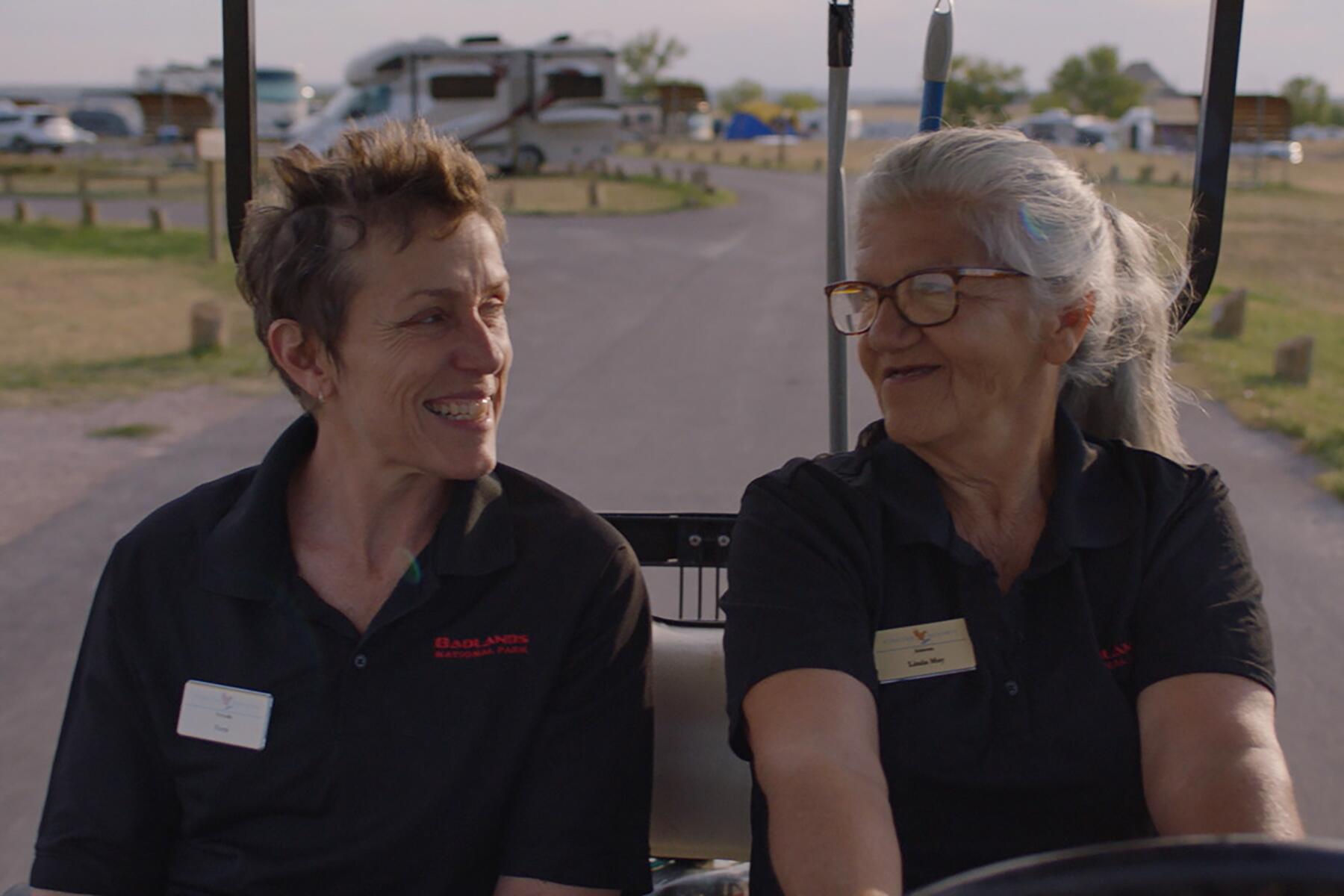
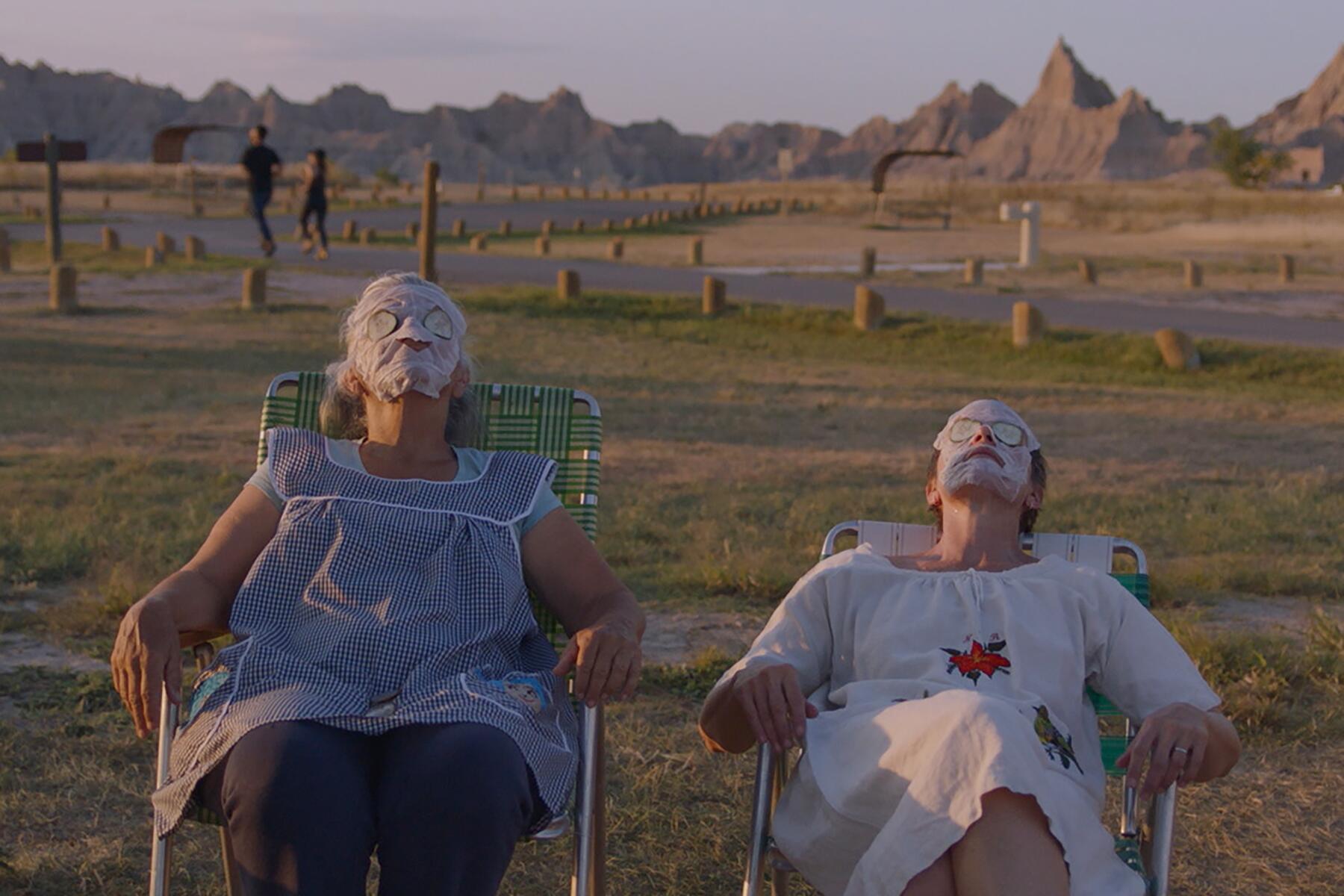
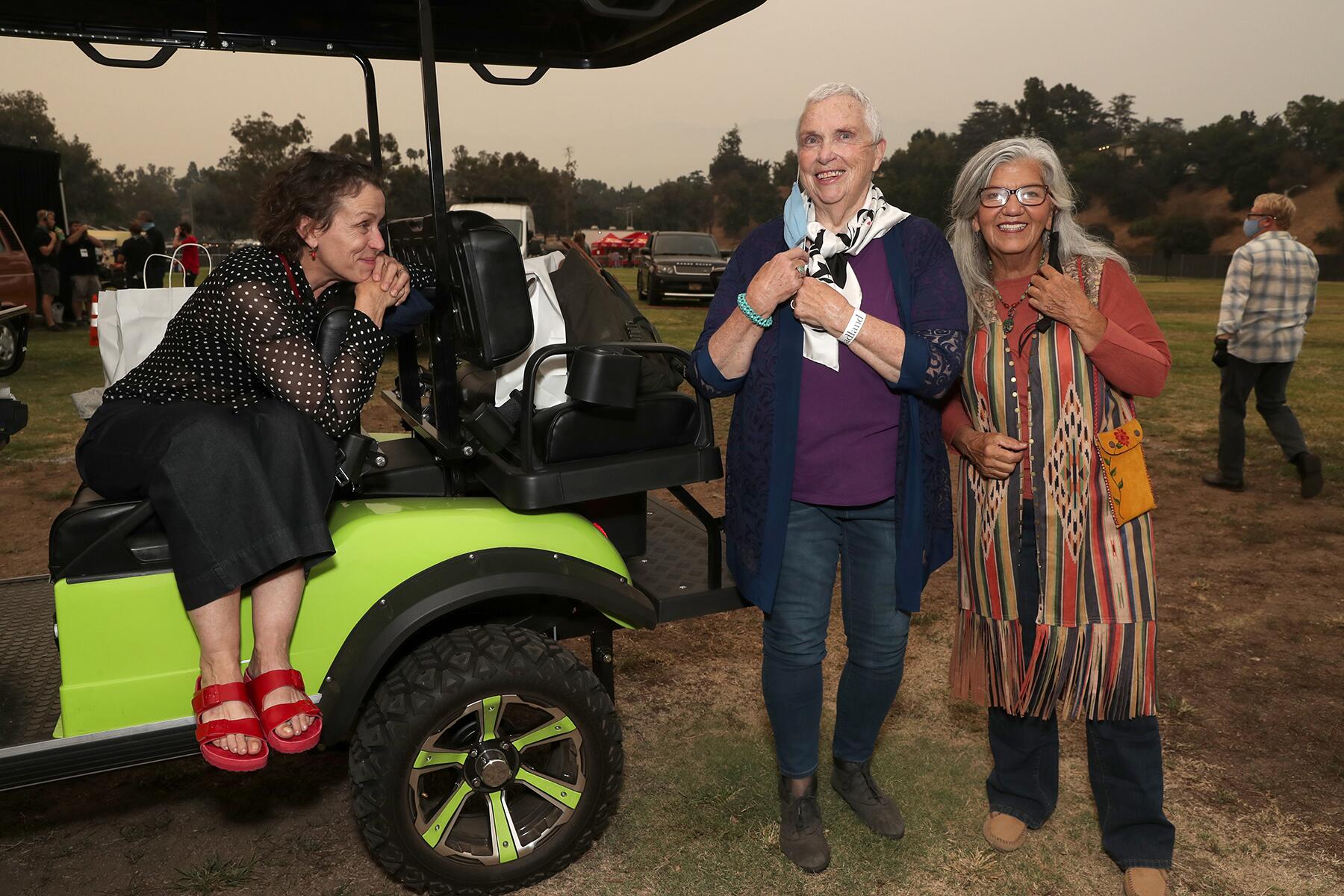
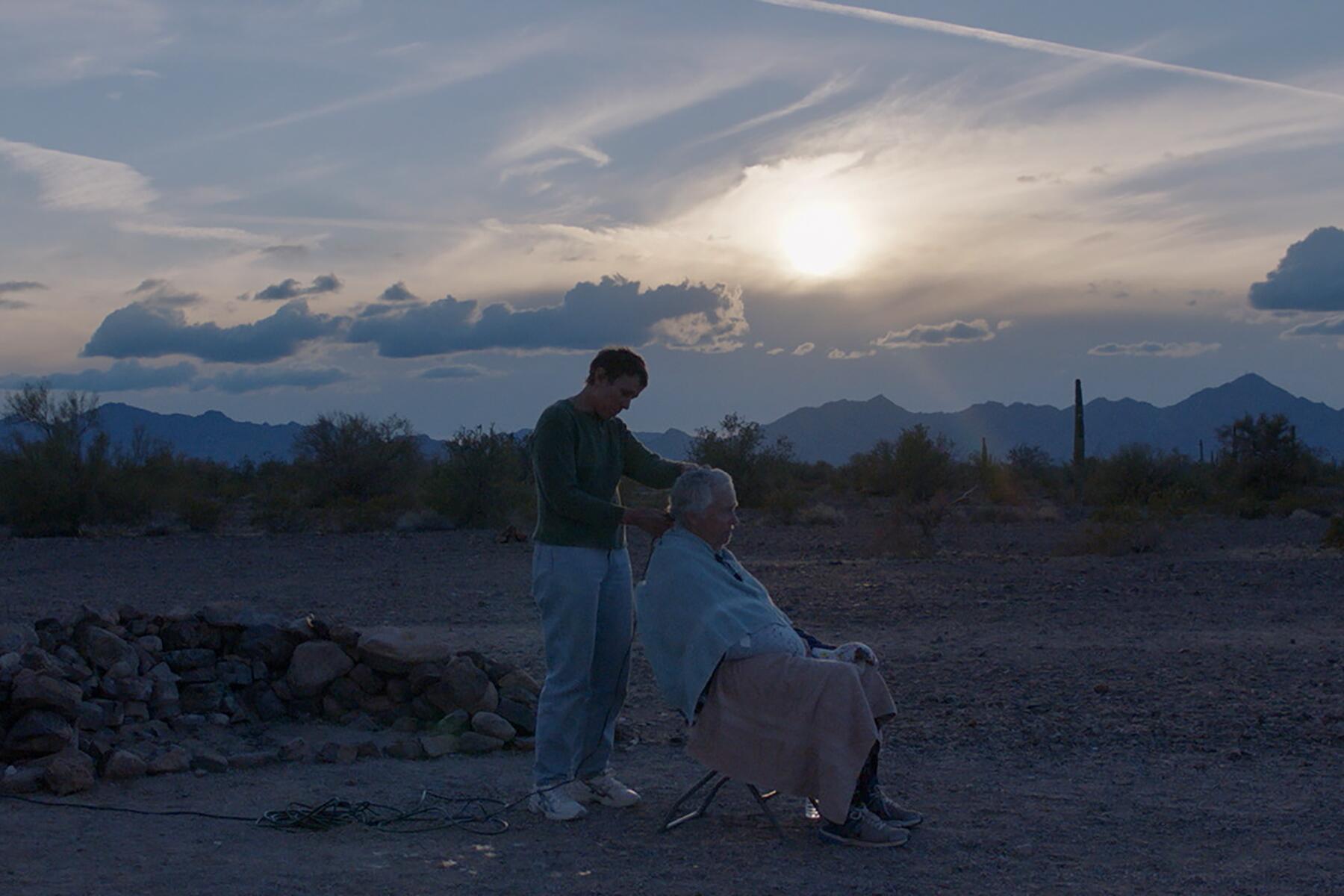
What a wonderful story! I so admire the spirit of everyone. I too am about to start a nomadic lifestyle.